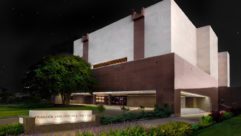

The January 2002 issue of Sound & Video Contractor contained an overview of the three basic options for wide area assistive listening systems (ALS): radio frequency (FM), inductive loop (IL), and infrared (IR). For reference, this earlier article remains available online at www.svconline.com.
This year’s update article takes an in-depth look at one of the two most popular technologies, FM.
UPSIDES AND DOWNSIDES
FM systems have captured the lion’s share of the ALS market for a variety of reasons. First, as a group, they are available at the lowest cost: off-the-shelf prices dip as low as $300 for a bare-bones system with a transmitter and four receivers. Installation can be accomplished in a few minutes when no remote antenna is needed, and the transmitter antenna can be placed behind the audience or even hidden from view. FM function is unaffected by bright indoor light or outdoor sunlight. Dozens of channels are available in two frequency ranges, allowing use of multiple simultaneous programs in the same facility. Finally, the FM signal easily passes through most walls, making it available for reception in multiple rooms or even outside — for better or worse.
Caution: wall penetration can be a problem for FM, one that must not be forgotten at the peril of facing legal action. Many churches, for example, may have no qualms about broadcasting Sunday services throughout the neighborhood but would rather not have more private affairs such as weddings and funerals accessible outside the walls. Courtrooms, movie theaters, and performing-arts centers use IR systems almost exclusively for that very reason. Consequently, you must be absolutely certain that your customer has no overriding privacy issues before installing any FM-based system.
Compared to IR systems, the other downside for FM is the potential for interference. Although the two frequency ranges used by all ALS systems are restricted by Federal Communications Commission (FCC) regulations, problems can surface, particularly in urban areas where churches, schools, and auditoriums are clustered in close proximity. Multichannel systems usually allow users to skirt around such problems (with neighborly cooperation), but for other users, it may be better to pre-empt such headaches completely with an IR installation.
Finally, IR systems accommodate stereo more easily than FM and can offer an edge in end-to-end performance, though the perceptible advantage in spoken-word applications is probably not significant when comparing systems of equivalent overall quality.
DIFFERENCES IN DETAILS
All ALS systems made for general use employ the same two frequency ranges, and most transmit with the maximum power the FCC allows. Because the underlying technology is the same, basic performance parameters for the various systems will be similar, particularly when compared with inductive loop systems or the old, abandoned AM-based systems. All receivers have output power in the same general range and the same minijack connector, so most output devices — earbuds, headphones, and neck loops for IL-equipped hearing aids — are largely interchangeable. All systems must meet some basic ADA-mandated requirements, such as availability of both microphone- and line-level inputs.
Therefore, a decision about which system is appropriate for an application boils down to a number of critical details, any one of which can spell the difference between smooth sailing and annoying problems.
BEST FREQUENCY RANGE?
ALS systems using FM technology are available in two distinct frequency bands, each of which is governed by a separate set of FCC regulations. The first range, 72 to 76 MHz, was designated for ALS use by the FCC in 1982, and it shares these frequencies with some public-safety applications. However, because both applications are subject to the same power restrictions (80 mV/m at 3 meters), interference is unlikely unless the public-safety user is right next door or attending to an emergency on an adjacent street. However, the wider use of this range does make interference more likely, particularly from other ALS users in the immediate vicinity.
The newer range, 216 to 217 MHz, was allotted exclusively for ALS use by the FCC in 1996. It offers higher power (here specified as 100W effective radiated output) for greater coverage area. The 72 to 76 MHz systems normally work for distances of 300 feet line-of-sight with an attached whip antenna (up to 1,000 feet with an ideally placed external antenna); the 216 to 217 MHz systems claim roughly double the range under similar circumstances.
As a general rule, the lower range will offer greater chance of receiver compatibility, as well as more channel options because the range is much broader. On the other hand, the less utilized (for now) higher range minimizes the chance of interference and also offers coverage over greater distances.
WIDE- OR NARROWBAND?
Both frequency ranges may be subdivided into wideband or narrowband channels. Prior to 1989, specific center frequencies for the wideband channels were dictated by the FCC in the 72 to 76 MHz range, and though many current systems maintain those specific channel frequencies, the manufacturers are now free to chop up the band as they please to foster technological innovation. Some manufacturers will offer the standard channels for compatibility along with their own proprietary high-performance channels with a companded signal.
A quick FM refresher: wideband and narrowband refer to the amount of deviation from the assigned center frequency. In ALS ranges, wideband deviation is generally 75 kHz maximum, and narrowband is 10 kHz maximum. The amount of deviation relates to potential signal to noise, while frequency response is determined by the rate at which the signal changes from the center frequency to maximum deviation and back again. narrowband systems are more expensive because they need better circuitry to achieve comparable signal to noise and must have digitally synthesized tuning circuits (PLL) to maintain tight frequency stability. Better wideband systems also use the PLL circuits, though some inexpensive receivers use manually tuned automatic frequency control circuits.
The bottom line: wideband systems offer a better chance of intermanufacturer compatibility and are available in the lower price range. narrowband offers more channels, and for comparable performance, the receivers are usually more expensive. In most cases, transmitters that offer narrowband channels also offer wideband channels as well, but not vice versa.
OTHER CONSIDERATIONS
These other factors also must be considered before specifying a system for a particular application:
Single channel or multichannel. All transmitters except two low-priced units offer multiple channel operation, which is essential in nearly all circumstances. The question then becomes whether to gamble on single-channel receivers or go with costlier multichannel units.
Tuning method and channel lock. If you go the multichannel route, how are the receivers tuned? The chart on p. 50 shows autotuning (frequency scan), specific channel presets, user channel switching, and field selection using some kind of tool. Note that when user selection is available, some method of locking channels is preferred to prevent inadvertent user switching.
Inputs and connectors. The ADA mandates both line and microphone input capability, though these may be separate or share (as some models do) a single connector. Better transmitters will offer mic/line mixing.
Battery life, cost, and recharging options. Ensuring fresh power can be the most tiresome part of maintaining ALS systems. Battery life will vary with actual use, of course, but the table provides a rough guide. With one exception (noted in text), all provide in-case battery recharging, though there is wide variation in how many units can be recharged simultaneously.
Processing (equalizing and compression/limiting). Most transmitters provide a basic automatic gain control circuit, but others offer more sophisticated compression and limiting and selectable EQ options. In the table, a Y indicates user-selectable or user-adjustable options.
Compander circuit. Compander circuits boost the effective signal-to-noise ratio and are a nice plus if the system carries music and the receiver has good headphones. Note that compander circuits are often proprietary and may not be compatible across different manufacturers’ systems.
AVAILABLE SYSTEMS
The following overview covers FM large area systems in the two designated ALS bands. Personal systems, though using the same frequencies, are not included nor are higher power systems (primarily for stadium use) operating at the lower end of the commercial FM band.
Comtek is an established player in ALS and offers a complete range of U.S.-made, industrial-strength transmitters and receivers. The entry-level base station, the M-72 BS, is a docking station device that connects the innards of Comtek’s removable M-72 body pack transmitter to the larger base station’s audio and RF connectors and power supply. In the 72 to 76 MHz range, Comtek also offers the BST-50 and BST-50b, both with essentially the same features but with the BST-50 offering 10 wide- and 40 narrowband channels and the BST-50b providing 88 narrowband channels.
In the 216 to 217 MHz range, the BST-25/216 again offers the same inputs and features as the BST-50 but with 57 channels. All the BST series transmitters offer a 2:1 companding mode on selected channels (for improved S/N with compatible receivers) and a test tone for tuning non-PPL receivers.
In the 72 to 76 MHz range, Comtek offers three types of receivers: the lower-cost PR72b is a fixed, single-channel unit, and the PR-25 provides field selection using a pair of recessed rotary switches. New to the line is the sleek and simplified PR-75, which uses a single push button to scan for any available signal. The PR-216 is essentially a twin of the PR-75 for use in the 216 to 217 MHz range.
Gentner has disappeared as a company, swallowed up by the ClearOne empire, but the highly regarded Gentner ALS line continues with distribution and support from Indiana-based Starin Marketing. The line includes what are essentially twin systems for the two frequency ranges, with the 72 to 76 MHz products using the TX-37A base transmitter and the 216 to 217 MHz systems built around the Venture-Base unit. Both transmitters employ relatively sophisticated preprocessing (including an Aphex exciter circuit to enhance voice intelligibility) and selectable EQ curves. Channel selection is on the rear panel to prevent tampering, and input options include speaker, line, and mic levels on RCA and XLR connectors. Another nice touch is the RF level selector for full, half, or quarter power output.
Two of the receiver options are essentially twins, as well. The Digital 1 (72 to 76 MHz) and Venture 1 (216 to 217 MHz) are small, elegant units that are field tunable using digitally synthesis circuitry. The Digital-6 and Venture-6 are similar but offer six thumbwheel-selectable channel presets in their respective frequency ranges. The low-cost RX-1A, available in the lower frequency range only, is field tunable to a single frequency using AFC circuitry.
Oregon-based Lightspeed Technologies offers a modestly priced 216 to 217 MHz system with advantages for applications where the audience is likely to include users of PHONAK MicroLink units (miniature receivers that plug directly in to selected hearing-aid models). Lightspeed’s 311TX base station offers 16 channels compatible with PHONAK’s Band NB frequencies. Other base station features include balanced and unbalanced inputs with input mixing, adjustable headphone output, and removable antenna for remote positioning. The lightweight (0.18 pounds with battery) body pack offers user selection of two fixed frequencies from four channel groups.
Listen Technologies’ line of ALS products is smart looking and offers features, particularly in receivers, that enhance flexibility in more demanding applications.
The twin LT-800 transmitters (one for each frequency range) are identical in features: dual inputs with input mixing, input and mix level metering, continuously variable EQ contour for voice or music optimization, test tone, and variable headphone level. Like the Gentner units, both offer three RF output power levels.
Listen engineers certainly did their homework before designing the three-tier receiver line. The top-level LR-500 offers autoseek tuning as well as the ability to program and lock only certain channels, with access to tuning controls concealed behind the battery compartment door. The LR-400 offers the same performance and features except for lack of programmability but for about $40 less per unit. These two are available in both frequency ranges, whereas the more basic (and lower cost still) LR-300 is tuned manually to one of 17 wideband channels in the 72 to 76 MHz range only.
A pioneer in wireless microphones, Nady Systems comes in with the low-price leader of the group. No frills here, though the ALD-800 system does offer creditable performance and meets all particulars for ADA compliance. In less demanding applications, such as small churches in rural areas, this could be just the ticket for meeting the letter of the law while conserving funds for the main sound system. However, using the ALD-800 in dense RF environments or in larger structures is not recommended, because there are no provisions for remote antenna placement, and both transmitter and receiver channels are fixed and must be changed at the factory — at a cost likely to rival the low initial investment. Also, in-case battery recharging is not offered.
The PE 560T transmitter from Phonic Ear, available for the 72 to 76 MHz band only, has a clean, high-tech look with all adjustments on push-button controls. The mic and line inputs use a single combination ¼-inch/XLR connector, and this unit is the only one surveyed here to offer speaker level inputs on terminal blocks — quite handy if the best location is accessed by an existing 70V feed. The PE 500R receiver can be field-tuned to any of ten wideband channels, while the PE 506 R allows user selection of six pretuned narrowband channels.
If you’re looking for stereo and a built-in speaker in the receiver, then the Drake systems stand out with features not found in the others. The ALT-1000 transmitter has a full-width 1U rackmount cabinet (again, the only wide one in the class), with large frequency readout display and big rotary controls for the audio input and headphone monitor levels. A three-position rear-panel switch selects compression, selects compression and limiting, or leaves both off. Both ¼-inch and XLR connectors are provided for left and right channels, and a ground lift switch is available to defeat (sometimes) annoying hum problems. If you don’t need stereo and want to save money, the compact (half rackspace) ALT 72 mono transmitter offers otherwise equivalent performance, with basic front-panel controls for channel selection (ten available), compression and limiting, and input level. The compact MR306 receiver is surprisingly light at 0.21 pounds and keeps net weight low by using — again, alone in the class — AAA batteries. The receiver can use mono or stereo output devices and offers user selection of five preset frequencies but with a lock feature to prevent accidental switching.
Telex is known for making solid, no-nonsense products, and the Sound Mate ALS systems are certainly no exception. Built like a tank, the ST-200 transmitter provides front-panel selection from 16 wideband channels through a recessed, front-panel switch. The rear panel has balanced and unbalanced input jacks, with the balanced XLR switchable for line, mic, or speaker level. Both have screwdriver-level adjustments. RF output power is switchable for two ranges.
The SR-100 synthesized has 16 user-selectable channels. Selection knob is nonlockable, but a different knob orientation with firm detents minimizes accidental switching. The SR-100 also has a push-button presence boost switch. The lower cost SR-50 receiver has one factory-fixed channel and lacks the presence boost switch.
Williams Sound has built a strong following through designing systems with innovative features, particularly in the transmitters, and offering them at modest cost. The latest entry, the PPA 375, incorporates fairly sophisticated digital signal processing (DSP) — based preprocessing yet makes adjustments user friendly. The T35 transmitter incorporates DSP to create presets that optimize EQ filters and compression for music or voice programs. The sleek front panel has a large LCD that displays various menus for accessing RF output, input sensitivity, and frequency band selection.
The P35 receiver is straightforward and affords exemplary performance. It is field tunable to any one of ten simultaneously available wideband channels and claims a long 80 hours of life on two AA alkaline batteries.
Bruce Borgersonis principal of Wavelength Communications, a consulting firm in Ashland, Oregon. His 30-year audio career spans live sound mixing, system installation, studio recording, and equipment marketing.
For More Information
Comtek
www.comtek.com
Gentner
www.gentnerals.com
Lightspeed Technologies
www.lightspeed-tek.com
Listen Technologies
www.listentech.com
Nady Systems
www.nadywireless.com
Phonic Ear
www.phonicear.com
R. L. Drake
www.rldrake.com
Telex
www.telex.com
Williams Sound
www.williamssound.com









